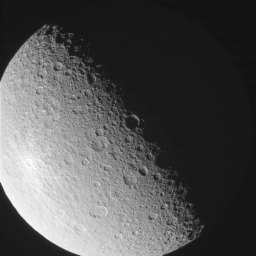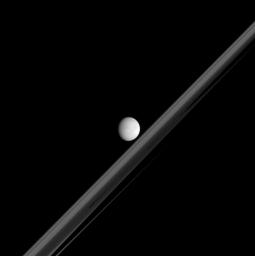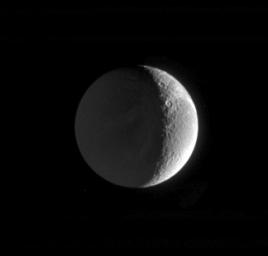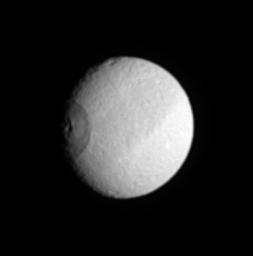 View of Titan from Cassini 30 minutes into ISS' high resolution observation (sub-spacecraft point=7.16N, 26.75W). The plot was generated in GISS' Titan 24 software. The map is derived from ISS map released last month (ask for full version used here, just adds blank space north of 34N). The full version of above plot is available. The data for plot was obtained from Mission description document.
View of Titan from Cassini 30 minutes into ISS' high resolution observation (sub-spacecraft point=7.16N, 26.75W). The plot was generated in GISS' Titan 24 software. The map is derived from ISS map released last month (ask for full version used here, just adds blank space north of 34N). The full version of above plot is available. The data for plot was obtained from Mission description document.
JPL has released the mission description for this week's 1025-km altitude, Titan flyby over the sub-Saturnian hemisphere. The usual goodies are include like instrument goals for the flyby, timeline of events, and the playback table to you (and I) can have a reasonable idea of when the data will be played back. Like T4, most of the data is played back at a reasonable hour, the early to mid morning period on Sunday. Some earlier encounters had data coming back in the late evening.
T5 is largely a magnetospheric flyby with "MAPS" instruments like MAG, MIMI, RPWS, and CAPS taken up much of the observing time after closest approach.
A few facts about this encounter:
- Occurs on April 16 at 1:28 pm PDT
- Closest Approach Distance = 1025 km (bumped up from 950 km)
- Relative speed WRT Titan = 6.1 km/sec
- Closest Approach Lat and lon = 74N, 272.5W
- First near-polar pass (74N at C/A)
- Outbound flyby (sunlit inbound)
- Phase angle at -3hours = 57 deg.
Here are some highlights in the flyby goals:
- ISS will once again look at the sub-Saturnian hemisphere. Unlike the last flyby where ISS imaged much of the visible hemisphere at global-scale (~1.5 km/pixel) resolution, on this encounter, ISS will get 12, higher resolution (725-250 m/pixel) snap-shots across the disk, including some along the T03 SAR swath). This is to designed to understand features seen upclose on the last encounter as well as to give VIMS optimum spatial coverage.
- This is the most important Titan flyby for MAG and is also very important for CAPS. The flyby geometry (both in terms of its low altitude and approach geometry) is close to optimum for electromagnetic studies of Titan's interior via induction effects. Both CAPS and MAG will examine Titan's Alfven currents that couple Titan to Saturn's magnetosphere. This will allow better understanding of the origin of Alfven wings and slow mode wings. MAG will use the low altitude to search for an internal magnetic field with a dipole near the rotation axis. CAPS will be prime for 16 hours after closest approach to observe signatures of Titan's interaction with Saturn's magnetosphere.
- INMS (Ion and Neutral Mass Spectrometer) will use its open source channel at closest approach to measure minor ion and neutral densities and to help calibrate data taken during the Titan flyby last October.
- CIRS (Composite Infrared Spectrometer) will search for new species at high northern latitudes (~55 deg) and will map CH4, CO, and HCN, etc. distribution by examining lon-wavelength rotational lines.
- VIMS will map parts of the northern sub-Saturnian hemisphere as well as map the sub-Saturnian hemisphere during the ride-along with ISS mentioned earlier.
- UVIS will map Titan's atomic emissions, acetylene distribution (a chemical that has taken on new prominence), and haze properties.
- RPWS (Radio and Plasma Wave Science instrument) will measure large-scale and distant aspects of Titan s interaction with Saturn s magnetosphere by observing during entire period around closest approach and from 10 to 25 Saturn radii.
Images start being played back at 6:56 am on Sunday morning. Playback continues (for imaging) until 11:30 am. How does this translate into being placed on the JPL Raw images page? On T4, images didn't show up until almost a day after images had been returned to earth, to the disappointment of the public and to the consternation of the imaging team who couldn't even release slightly processed images until after JPL had the images up on their raw images page. Hopefully, there won't be the same delay on this flyby but I can't make any guarantees. Depending on how JPL has the system setup, given that it is a Sunday when these images come down, it could be Monday before the images start showing up.







